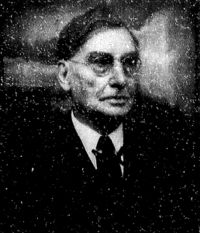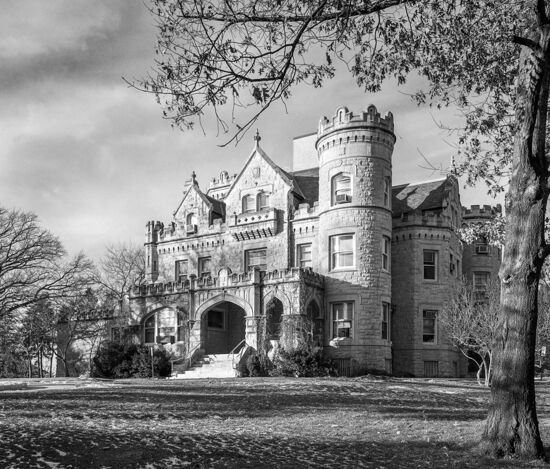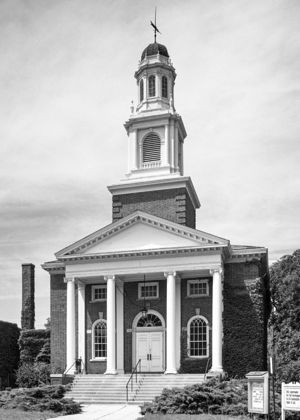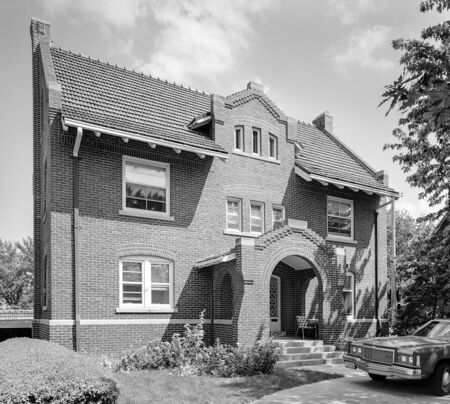John McDonald (1861-1956), Architect
John "Jack" McDonald was born April 22, 1861 in Prince Edward Island, Canada. He was the son of Mr. & Mrs. Angus McDonald and second born of eleven children. The McDonalds are a family of Scottish heritage. John received his education in civil engineering in Canada, earning his Bachelor of Science from McGill University in 1884. McDonald moved to Omaha after graduation, quickly finding work in the office of Omaha architect Sidney Smith.[7][12:3,111][a] By 1887, McDonald's McGill classmate and friend David Ogilvy joined him in Omaha to open the firm of McDonald & Ogilvy, which designed a number of residential and commercial buildings.[16][20] McDonald married Martha Tibbetts in 1890 and Ogilvy left Omaha for Portland, Oregon about that same time.[12:5] But the classmates' architectural partnership continued a few more years, styled as "Ogilvy & McDonald" in Portland and "McDonald & Ogilvy" in Omaha. A dissolution of the partnership was announced in 1892 and each man accomplished major commissions in later years.[17] Ogilvy returned to Canada in 1896 and practiced in Montreal until 1914.[18]
McDonald remained in the rapidly developing city of Omaha where his close friendship with George Joslyn granted McDonald access to other big-name clients. Joslyn hired John at only 30 years old to design his estate. The personal friendship between the Joslyns and McDonalds was valuable as well.[12:46] In 1917, John established a partnership with his son, Alan McDonald, which lasted until Alan's death in 1947. John is recognized for 66 years of noteworthy contributions to the city of Omaha. He died on May 7, 1956, and is interred in Forest Lawn Memorial Park in Omaha. Joan M. Fogarty, biographer of John and Alan McDonald, noted that "Jack's personal belief as an architect was that a building should last forever, and that is how he built them." She opines that "Fortunately, because of this belief, many of his buildings are still standing and in use today."[7][10][12:13]
This page is a contribution to the publication, Place Makers of Nebraska: The Architects. See the format and content page for more information on the compilation and page organization.
Contents
Compiled Nebraska Directory Listings
Omaha, Nebraska, 1892-1950, 1953-1954
Educational & Professional Associations
1868-1880: Private, grammar, and normal schools, Prince Edward Island, Canada.[7][12:1]
1881-1884: Bachelor of Science, Civil Engineering, McGill University, Montreal, Canada.[7]
1885-1886: partner, Sidney Smith, Architect, Omaha, Nebraska.[7][19][f]
1887-1891: partner, McDonald & Ogilvy, Architects, Omaha, Nebraska and Portland, Oregon.[7]
1892-1917: John McDonald, Architect, Omaha, Nebraska.[7]
1917-1946: partner, John & Alan McDonald, Architects, Omaha, Nebraska.[7]
1938: Registered Professional Architect, Nebraska, February 15, 1938; A-46.[7]
1949-1955: John McDonald, Architect, 604 Standard Oil Building, Omaha, Nebraska.[a]
Other Associations
1901: employed F. William Krelle, draftsman.
1906: employed Max Nippell, draftsman.
1908-1910: employed Arthur Dixon Baker, draftsman.
Buildings & Projects
1886-1891
Jack McDonald's initial projects were carried out during the period of his early partnership with David Ogilvy, which extended to May 1, 1891. In the last year or so of that span, Ogilvy was located in Portland, Oregon and listed the practice there as "Ogilvy & McDonald." SEE McDonald & Ogilvy, Architects for the projects of this partnership.[17]
1892-1899
George A. & Sarah Joslyn Estate aka Joslyn Castle (1892-1903), 3902 Davenport St., Omaha, Nebraska.[3:113][4][5][12:14] (DO09:0321-001) National Register narrative
G. William Carlock House (1896), 1314 S 30th Ave., Omaha, Nebraska.[3:78][5] (DO09:0204-115)
House (1897), 3102 Woolworth Ave., Omaha, Nebraska.[5][8] (DO09:0204-136)
House (1897), 3104 Woolworth Ave., Omaha, Nebraska.[5] (DO09:0204-135)
House (1897), 3106 Woolworth Ave., Omaha, Nebraska.[5] (DO09:0204-134)
Williams-Bostwick House (1892-1898-191?), 3716-22 Dewey Ave., Omaha, Nebraska.[4][5] (DO09:0319-012)
Nebraska Building (1898), Trans-Mississippi and International Exposition, Omaha, Nebraska.[1:160][12:15][b]
Apiary Building (1898), Trans-Mississippi and International Exposition, Omaha, Nebraska.[1:132][2][12:16]
1900s
First Baptist Church (1901), Park Ave. & Harney St., Omaha, Nebraska.[12:11]
Flat (1904), 2552 Harney St., Omaha, Nebraska.[5] (DO09:0209-040)
Dr. Paul Grossman Town Houses (1904), 102-108 S. 36th, Omaha, Nebraska.[5][12:36] (DO09:0319-002)
F.E. Pearce House (1904), 119 S. 37th, Omaha, Nebraska.[5] (DO09:0319-062)
First Christian Church (1905), 26th & Harney St., Omaha, Nebraska.[12:10]
House for Mrs. Horbach (1905), 120 N. 32nd St., Omaha.[5][12:44] (DO09:0212-058)
Charles D. McLaughlin House (1905), 507 S. 38th St., Omaha, Nebraska.[4][5] (DO09:0317-004) National Register narrative
Frank Blish House (1905), 117 S. 37th, Omaha, Nebraska.[5] (DO09:0319-061)
Harry P. Whitmore House (1906), 3905 Dewey Ave., Omaha, Nebraska.[4][5][12:37] (DO09:0317-015)
Alex G. Buchanan House (1906), 1330 Turner Blvd, Omaha, Nebraska.[3:174][5] (DO09:0204-077)
L.L. Black House (1906), 3808 Harney, Omaha, Nebraska.[4][5] (DO09:0319-047)
Brandeis Commercial Building (1906), 1012-1014 S. 10th, Omaha, Nebraska.[4][5] (DO09:0119-017)
House for Fred Squires Knapp (1906), 1330 S. 35th St., Omaha, Nebraska.[12:29]
W. A. DeBord House (1907), 3520 Woolworth Ave, Omaha, Nebraska.[3:182][5] (DO09:0204-063)
F. Knapp House (1907), 1330 S. 35th St., Omaha, Nebraska.[3:97][5] (DO09:0204-065)
House for Mr. DeBord (1907), 3520 Woolworth Avenue, Omaha, Nebraska.[12:28]
House for Mr. & Mrs. John Webster Towle (1907-1908), 3602 Pacific St., Omaha, Nebraska.[12:27]
J.W. Thomas House (1908), 3820 Harney, Omaha, Nebraska.[4][5] (DO09:0319-050)
House for G. Day (1908), 1310 Turner Blvd, Omaha, Nebraska.[3:173][5][12:29] (DO09:0204-073)
House (1908) 1330 Turner Blvd., Omaha, Nebraska.[12:26]
House (1908) 3303 Woolworth Ave., Omaha, Nebraska.[12:26]
House (1909), 2202 Hanscom Blvd, Omaha, Nebraska.[3:129][5][12:26] (DO09:0200-027)
House for H. Fish (1909), 3311 Woolworth Ave, Omaha, Nebraska.[3:181][5][12:28] (DO09:0202-036)
George H. Thummel House (1909), 404 S. 38th St., Omaha, Nebraska.[4][5] (DO09:0319-015)
Porter-Phalen House (1909), 444 N. 38th St., Omaha, Nebraska.[5][12:41] (DO09:0323-017)
Omaha Printing Company (ca. 1909), 13th & Farnam St., Omaha, Nebraska.[12:69]
E. F. Howe House (ca. 1909), 29th & Pacific, Omaha, Nebraska.[14]
1910-1916
Bradford-Pettis house (1910), 404 S 39th St., Omaha, Nebraska.[3:101][4][5][12:35] (DO09:0319-008) National Register narrative
First National Bank of Imperial (1910), Imperial, Nebraska.[15][g]
Rowhouse (1910), 3040-42 Cass St., Omaha. Nebraska.[5] (DO09:0214-015)
Commercial Building (1910), 3928 Farnam, Omaha, Nebraska.[5] (DO09:0319-046)
Arthur English/J.A.C. Kennedy House (1910-1911), 521 N. 38th St., Omaha, Nebraska.[5][8][12:38] (DO09:0323-011)
Building (1911), 601 N. 16th St., Omaha, Nebraska.[5] (DO09:0127-017)
John & Martha McDonald House (1911), 515 N. 38th St., Omaha, Nebraska.[5][8][12:39][13] (DO09:0323-012)
Barton Millard House (1911), 3650 Burt St., Omaha, Nebraska.[12:42]
The Child Saving Institute (1912), 619 S. 42nd St., Omaha, Nebraska.[12:57]
Drummund Motor Company Building (1912), 2570 Farnam St., Omaha, Nebraska.[5] (DO09:0209-015)
House (1912), 130 N. 39th St., Omaha, Nebraska.[5] (DO09:0321-024)
The Joslin Memorial Library (1913), Waitsfield, Vermont.[12:58][d]
Mrs. Martha A. Fitzgerald House (1913), 113 S. 38th St., Omaha, Nebraska.[5] (DO09:0407-026)
Beebe & Runyon Furniture Showroom & Warehouse (1913), 105 S 9th St., Omaha, Nebraska.[3:41][4][5][12:67] (DO09:0068-001) National Register narrative
Commercial Building (1913), 1416 Howard St., Omaha, Nebraska.[5] (DO09:0121-041)
Benjamin F. Marshall House (1913), 3646 Burt St., Omaha, Nebraska.[5][12:42] (DO09:0325-018)
W.L. Coakley House (1913), 204 S. 37th St., Omaha, Nebraska.[5] (DO09:0319-037)
Forest Lawn Memorial Park Chapel & Crematory (1913), 7909 Mormon Bridge Road, Omaha, Nebraska.[9][12:81]
Keen Hotel major Remodel (1914), 18th & Harney St., Omaha, Nebraska.[12:72]
Oblate House (1915), Creighton University, 2104 Davenport, Omaha, Nebraska.[3:112][5] (DO09:0126-013)
Commercial Building (1915), 2401 Farnam St., Omaha, Nebraska.[5] (DO09:0209-045)
The Creighton Working Girls' Home (ca. 1915), 22nd & Davenport St., Omaha, Nebraska.[12:71]
John Bachelor House (1916), 525 Main, Valentine, Nebraska. (CE14-082)
Muse Theater (1916), 2405 Farnam St., Omaha, Nebraska.[5][12:70] (DO09:0209-044)
Western Newspaper Union Building (1916), 621 S. 15th, Omaha, Nebraska.[4][5][12:62] (DO09:0121-069)
Henry Yates Elementary School (1916-1917), 3252 Davenport, Omaha, Nebraska.[3:112][5][12:77] (DO09:0212-002)
1917-1947
Alan McDonald graduated from Harvard in 1915 and joined his father's practice. Within a few years, he was recognized as a partner, which Alan remained until his death in 1947. SEE John & Alan McDonald, Architects for the projects of their joint practice.
Undated
E.W. Gunther House (n.d.), 320 N. 40th St., Omaha, Nebraska.[12:43]
House (n.d.), 405 N. 40th St., Omaha, Nebraska.[12:43]
E. A. Mills House (n.d.), 120 N 39th St., Omaha, Nebraska.[12:44]
Iten Biscuit Company-Snow White Bakery (n.d.), 12th & Capitol St., Omaha, Nebraska.[12:68]
Phalen-Shirley Building (n.d.), SW corner of 24th & Farnam St., Omaha, Nebraska.[12:70]
Honors & Awards
Omaha Chamber of Commerce Recognition for 66 years of service. [12:107]
Notes
a. McDonald's first professional steps in Omaha are not crystal-clear. Fogarty indicates that "Jack" landed in an Omaha architectural office by 1884, and points out that a John McDonald was listed in the 1885 Omaha directory as a "civil engineer," which matched his McGill degree. However, the 1886 directory listed both a John McDonald, architect, and a John A. McDonald, civil engineer, suggesting two different men. Yet their listed residential addresses--907 S. 20th and "b[oar]ds S. 20th n[ea]r Marcy" respectively--point to the same location. Directories are crucial sources of local information but must be read with a measure of skepticism. McDonald's last Omaha directory listing came in 1955. In the business section of the 1954 and 1955 directories, McDonald is listed as John T. McDonald; it is not known if this represents his middle initial, or if it was a typographical error, as he is not known to have otherwise used a middle initial.
b. The Nebraska Building was a joint project of James H. Craddock, Lincoln, and John McDonald.[1:160]
c. [Temporarily left blank.]
d. The Joslin Memorial Library is the only known building John McDonald designed outside of the state of Nebraska. It is still in use today.[12:58] George A. Joslyn donated funds for the library, which is named for (and reflects the spelling of the surname of) his grandfather Joseph Joslin ((1776-1865). George used the same spelling of their surname as his father Alfred Joslyn (1822-1910).
e. The building caught fire when at near completion, and was rebuilt in cast iron.[12:61]
f. Both Sidney Smith and John McDonald were among the nine incorporators in January 1887 of the "Park Building Association" with an announced capital of $100,000. McDonald (but not Smith) was also one of the eight incorporators of the Farnam Street Building Association.[19]
g. Improvement Bulletin of January 29, 1910 credits "John MacDonnell, architect, New York Life building" of Omaha with "preparing plans for a bank building and hall" for Imperial, Nebraska. John McDonald was the only Omaha architect of similar name practicing in Omaha at that time and the 1909 Omaha city directory listed his office in the New York Life building (along with about 40% of Omaha's architects). In the 1910 directory he was listed in the Omaha National Bank Building, reflecting the building's principal occupant, rather than its developer (New York Life).[15]
References
1. James B. Haynes, History of the Trans-Mississippi and International Exposition of 1898 ([Omaha]: Committee on History, 1910).
2. “Trans-Mississippi and International Exposition,” Omaha Public Library Website, 1998. Images accessed July 7, 2003, <http://www.omaha.lib.ne.us/transmiss/buildings/apiary.html>
3. Landmarks, Inc., An Inventory of Historic Omaha Buildings (Omaha: Landmarks Heritage Preservation Commission, 1980).
4. Listed in the National Register of Historic Places.
5. City of Omaha Planning Department, Landmarks Heritage Preservation Commission, Database, Query on Architects, May 20, 2002; courtesy of Lynn Meyer, Preservation Planner.
6. AIA Historical Directory of American Architects: A Resource Guide to Finding Information About Past Architects, accessed June 1, 2010, http://communities.aia.org/sites/hdoaa/wiki/Wiki%20Pages/ahd1029358.aspx
7. Application for Registration to Practice Professional Engineering and Architecture, Nebraska State Board of Examiners for Professional Engineers and Architects, December 30, 1937. Nebraska State Historical Society RG081 SG2.
8. Erin Grace, “Homeowners Cherish and Preserve Their Link to Omaha’s Past,” Omaha World Herald (January 28, 2014), 1B-2B.
9. The Cemetery Handbook (Chicago: Allied Arts Publishing Co., ca. 1920), 184-187.
10. "John McDonald," Find A Grave Memorial # 146327972, May 11, 2015. Find A Grave.com Accessed July 27, 2016. http://www.findagrave.com/cgi-bin/fg.cgi?page=gr&GRid=146327972&ref=acom
11. “McDonald, Alan,” Who's Who in Nebraska. Lincoln: Nebraska Press Association (1928), 129.
12. Joan M. Fogarty, Building Omaha: The Architectural Legacy of John and Alan McDonald (Omaha: Elman Printing Company, 2013).
13. Meyer Collection; Omaha City Planning Department, 1980.
14. "Artistic Brick in Vogue--Change in Style is Now Being Used by the Architects in Handsome Residences," Omaha (Nebraska) Daily Bee (May 8, 1910), 39.
15. "Omaha...John MacDonnell [sic], architect...," Improvement Bulletin (January 29, 1910), 24.
16. "M'Donald & Ogilvy, Architects" (advertisement), Omaha (Nebraska) World-Herald (February 24, 1887), 2.
17. "To Whom It May Concern" (notice of dissolution as of May 1, 1891 of "McDonald & Ogilvy, doing business as Architects and Superintendents"), Omaha (Nebraska) Evening Bee (February 26, 1892), 6.
18. “Ogilvy, David,” Biographical Dictionary of Architects in Canada, 1800-1950, [on-line database]. Accessed December 16, 2023 at http://dictionaryofarchitectsincanada.org/node/115
19. "Park Building Association," and "Farnam Street Building Association," Omaha (Nebraska) Daily Bee (January 2, 1887), 15.
20. "McDonald & Ogilvy--Architects and Superintendents, Withnell Block, Omaha," Omaha (Nebraska) Daily World-Herald (June 25, 1887), 7.
Page Citation
D. Murphy & E. F. Zimmer, “John McDonald (1861-1956), Architect,” in David Murphy, Edward F. Zimmer, and Lynn Meyer, comps. Place Makers of Nebraska: The Architects. Lincoln: Nebraska State Historical Society, December 22, 2023. http://www.e-nebraskahistory.org/index.php?title=Place_Makers_of_Nebraska:_The_Architects Accessed, April 23, 2024.
Contact the Nebraska State Historic Preservation Office with questions or comments concerning this page, including any problems you may have with broken links (see, however, the Disclaimers link at the bottom of this page). Please provide the URL to this page with your inquiry.



